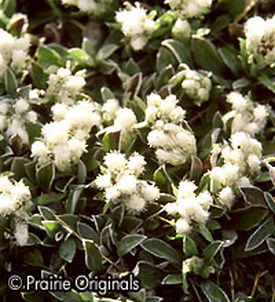Little-Leaved Pussytoes (Antennaria Parvifloia) |
Look deep into nature,
and then you will understand everything better. ~ Albert Einstein ~ |
 photo credit www.prairieoriginals.com
photo credit www.prairieoriginals.com
Little-Leaved Pussytoes (Antennaria Parvifloia)
This is a native mat forming perennial that stands 2 to 15 cm tall
It is an unusual plant in that there are almost no male plants, usually only females. Fortunately Little-Leaved Pussytoes succeeds well without a male and is able to produce abundant seeds.
Too much or too little grazing both cause it to grow poorly. Pussy-toes is considered an indicator plant because generally it grows in soils that are dry and where fertility is low. Increasing the fertility and moisture in the soil, will generally control this plant without the need to resort to poisonous herbicides. This can be achieved quite readily by growing cover crops that increase the organic matter and fix nitrogen.
Several types of moths and butterflies feed on this plant. Little-leaved pussytoes is one of the few flowers in the genus Antennaria, which is the only food source of the larvae of the nearly extinct Verna Flower Moth. Despite this fact, Little-Leaved Pussytoes is included in The Noxious Weed Act of Manitoba. The story of the Verna Flower Moth is shrouded in mystery. The adult moth is a pollinator because it requires nectar but it is unknown which flowers it visits for this need. There are native spring flowering plants in the habitat of the Verna Flower Moths such as 3 flowered avens, prairie crocus, fleabane and mouse eared chickweed. The lack of information, and the elusiveness of the insect means that its conservation needs are largely unknown. All that is definitely known is its requirement for the Pussytoes plant family for the survival of its larvae.
According to the Alberta Conservation Association, "The impact of agricultural chemicals on the Verna Flower Moths is unknown. Applications of herbicides and pesticides in occupied habitat would almost certainly have a negative impact on Verna's Flower Moths, along with other insects"(1) Scientists believe that we are witnessing a global biodiversity crisis. It is estimated that the current rate of global species extinction is 1,000 to 10,000 times greater than natural.(2) If the Verna Flower Moth does becomes extinct, its loss will surely have an impact on other creatures in its ecosystem because we are all connected.
We all have a responsibility to help conserve the wonderful flowers and plants that have evolved to live in this climate and ecosystem. When we protect many types of native flowers, we protect all the insects and other animals connected in their food and life webs. By using methods of controlling weeds that are not poisonous, such as correcting soil fertility and moisture instead of using toxic herbicides, we protect the plants, insects and animals living there. Providing space for pussytoes to grow, especially where native grasses and a diversity of native flowers are present, could prevent the extinction of rare and endangered moths.
(1)http://esrd.alberta.ca/fish-wildlife/species-at-risk/species-at-risk-publications-web-resources/invertebrates/documents/SAR-StatusVernasFlowerMothAlberta-Apr2008.pdf
(2)http://manitobawildlands.org/bio_species.htm
This is a native mat forming perennial that stands 2 to 15 cm tall
It is an unusual plant in that there are almost no male plants, usually only females. Fortunately Little-Leaved Pussytoes succeeds well without a male and is able to produce abundant seeds.
Too much or too little grazing both cause it to grow poorly. Pussy-toes is considered an indicator plant because generally it grows in soils that are dry and where fertility is low. Increasing the fertility and moisture in the soil, will generally control this plant without the need to resort to poisonous herbicides. This can be achieved quite readily by growing cover crops that increase the organic matter and fix nitrogen.
Several types of moths and butterflies feed on this plant. Little-leaved pussytoes is one of the few flowers in the genus Antennaria, which is the only food source of the larvae of the nearly extinct Verna Flower Moth. Despite this fact, Little-Leaved Pussytoes is included in The Noxious Weed Act of Manitoba. The story of the Verna Flower Moth is shrouded in mystery. The adult moth is a pollinator because it requires nectar but it is unknown which flowers it visits for this need. There are native spring flowering plants in the habitat of the Verna Flower Moths such as 3 flowered avens, prairie crocus, fleabane and mouse eared chickweed. The lack of information, and the elusiveness of the insect means that its conservation needs are largely unknown. All that is definitely known is its requirement for the Pussytoes plant family for the survival of its larvae.
According to the Alberta Conservation Association, "The impact of agricultural chemicals on the Verna Flower Moths is unknown. Applications of herbicides and pesticides in occupied habitat would almost certainly have a negative impact on Verna's Flower Moths, along with other insects"(1) Scientists believe that we are witnessing a global biodiversity crisis. It is estimated that the current rate of global species extinction is 1,000 to 10,000 times greater than natural.(2) If the Verna Flower Moth does becomes extinct, its loss will surely have an impact on other creatures in its ecosystem because we are all connected.
We all have a responsibility to help conserve the wonderful flowers and plants that have evolved to live in this climate and ecosystem. When we protect many types of native flowers, we protect all the insects and other animals connected in their food and life webs. By using methods of controlling weeds that are not poisonous, such as correcting soil fertility and moisture instead of using toxic herbicides, we protect the plants, insects and animals living there. Providing space for pussytoes to grow, especially where native grasses and a diversity of native flowers are present, could prevent the extinction of rare and endangered moths.
(1)http://esrd.alberta.ca/fish-wildlife/species-at-risk/species-at-risk-publications-web-resources/invertebrates/documents/SAR-StatusVernasFlowerMothAlberta-Apr2008.pdf
(2)http://manitobawildlands.org/bio_species.htm
